By Soh Rui Yong
[Editor’s note: The Rogue Run Half Marathon was held on September 21, 2014. This story was first published on Soh Rui Yong’s blog and is re-published with permission, with editions made to language and style not affecting the story.]
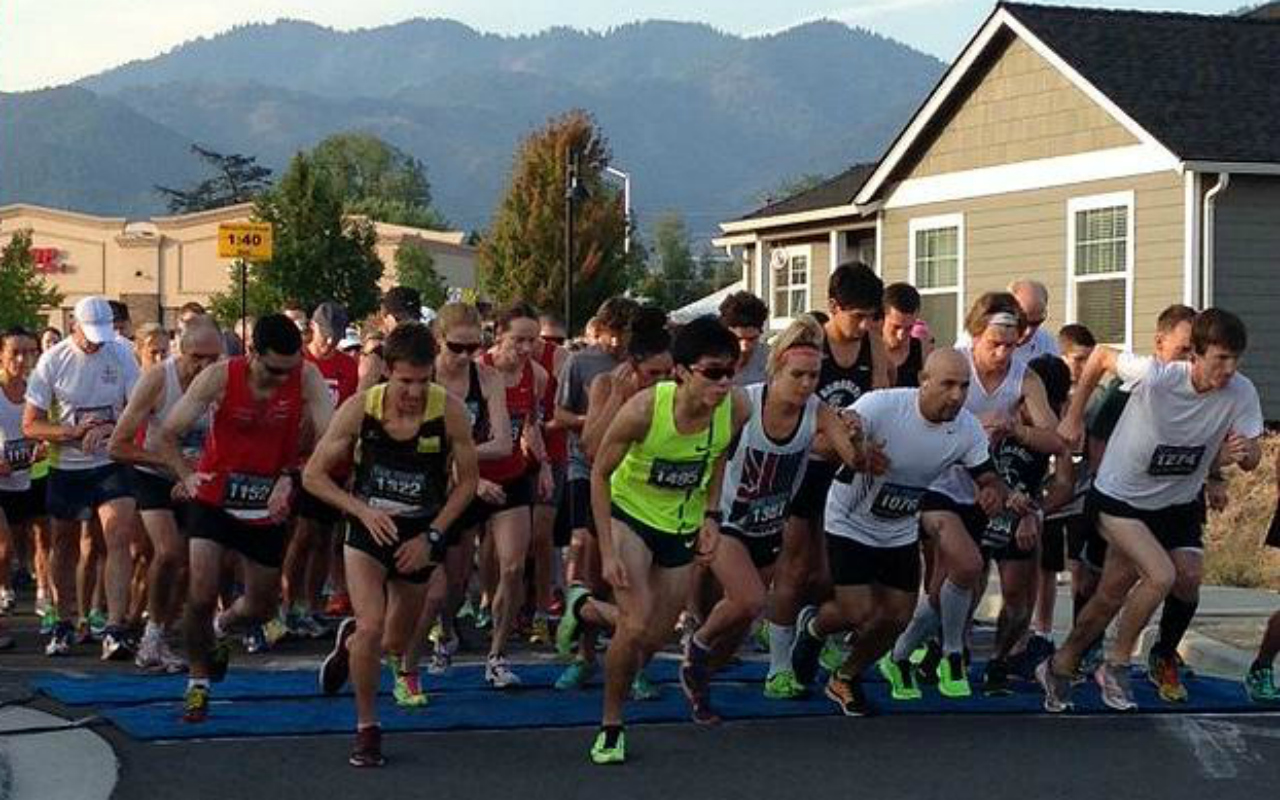
Soh Rui Yong (#1495, in yellow top) clocked 1 hour 7 minutes 52 seconds to finish second behind Team Run Eugene teammate Craig Leon at the Rogue Run in Medford, Oregon. His time was just 23 seconds off the national best mark set in June this year by Mok Ying Ren in Christchurch, New Zealand. (Photo courtesy of Soh Rui Yong. Used with permission)
Oregon, United States, Sunday, September 21, 2014 — The 2014 Rogue Run, held in Medford, Oregon, was the best ‘small race’ that I’ve ever had the opportunity to be a part of. It was a world of difference from the usual big city half marathons held in venues such as New York City, Copenhagen, Singapore, and the like.
Towering office buildings, shopping malls and massive, screaming crowds were nowhere to be seen, replaced by the lush greenery of Southern Oregon. Despite being a smaller race in comparison to more famous races like the New York City and Copenhagen Half Marathons, or the Army Half Marathon and Standard Chartered Singapore Half Marathon back home, the Rogue Run ticked all the boxes that make an event a positive experience for everybody.
Efficient distribution of number tags at race expo? Check. Efficient, comfortable shuttle service to the starting line? Check.
An accurately measured, fast course, certified by USA Track & Field (USATF)? Check, apart from a detour and sharp turns due to construction on the bike path (a factor out of the organisers’ control). The slight net downhill nature of the course was also within USATF’s allowable range, giving runners an added advantage in pursuing fast times.
Attractive prize money for top finishers? Check. $1000, $350 and $150 for first, second, and third respectively are not bad at all.
Efficiency and accuracy in getting results posted? Check, so well that it puts many other self-proclaimed ‘big races’ to shame. Add to that a station where runners could print out their individual results slip, Singapore military Individual Physical Proficiency Test (IPPT) style. Double check.
Post-race festivities in the form of massages and beers (both free of charge) were bonuses.
Quality, not quantity
It was a change of environment, a change of atmosphere, and an encouraging sign that anyone who is willing can put on an incredible running experience for the community. You don’t have to be rich or have an abundance of resources at your disposal. You just need to be willing to take feedback, and play within your resources. Overcrowding and the lack of resources to cope with big crowds are primary reasons why so many runs can leave a bitter taste in the mouths of participants. The Rogue Run made it about quality, not quantity, and it showed.
Best of all? Profits from the organisation of the race went to charitable causes.
Falling sick, three-hour drive, and race logistics
After some great training runs and knowing that I was in good shape, I spent Monday onwards of race week down with a cold. Getting more rest than usual and hoping for the best, I still managed to run every day of the week. In my experience, raising the body temperature with an easy jog or workout can kill off the germs.
I had to drive three hours to Medford from Eugene the day before the race, but the journey was made far more enjoyable because I got to travel with my new Team Run Eugene (TRE) teammate Mel Newbery. Just two months ago, Mel was on a long break from running and in no sort of race shape whatsoever, when I convinced (or “bullied”, as she would say) her into registering for the Rogue Run.
“Oh! There’s a 10km category. Should I do that instead?” Mel asked.
“Sure, if you want to be a wimp, go ahead!” I chuckled. (Disclaimer: I’m not saying that everyone who runs the 10km are wimps. I run the 10km very often myself. I just knew it was a great way to get Mel to sign up for the half marathon.)
Furious, Mel registered for her first-ever half marathon on the spot.
We checked in at our inn, got to the race expo, got our race entry packs, did a shakeout run, then grabbed dinner at an Italian bar. With a 5am wake-up time, we had to get to bed by 9pm in order to get enough rest.
As usual, my heart rate was higher than usual and it took a long while for me to fall asleep, but I wasn’t scared or nervous. I have not felt scared or nervous about a race for years now. I knew that my elevated heart rate was just my body’s natural reaction to the race that lay ahead – a tune up, to get the blood and red blood cells flowing through my system. Despite still suffering from a runny nose and a bit of a sore throat, I knew I was ready to give it a good go.
Race Day
Getting up at 5am, Mel and I had breakfast, then drove to the race expo, where shuttle buses were scheduled to take us to the start line, 13.1 miles (21.1 kilometers) away, the distance of a half marathon.
We warmed up, used the bathroom, deposited our bags, did some strides, then reported to the starting line. I linked up with teammate Craig Leon there (64 minutes 1 second half marathoner and 2 hour 13 minutes 53 seconds marathoner) and briefly chatted with him.
Craig didn’t have a target pace he was going to run but I, more or less, guessed he would run away with the win. Craig’s in fantastic shape right now, and was using the race merely as a tune up for the Chicago Marathon in three weeks. [Editor’s note: Craig Leon finished 19th at the Chicago Marathon in 2 hours 16 minutes.] I then made it my goal to try and keep Craig within sight for as long as possible, hold off everyone else for second, and make it a 1-2 finish for TRE in the men’s race.
For Mel, though it was her first half marathon, I knew that she had a very good chance of finishing in the top three of the women’s race and, perhaps, even had a shot at the win if she could run about 1:17 or 1:18. If I could finish second in my race, TRE would have an impressive showing. Craig, Mel and I wished each other luck, and prepared for the race ahead.
Go-time
The gun went off, and I kicked into a fast start. The first mile was downhill, which was tricky, and called for a bit of self-control. “Milking the downhills”, or sprinting on the downhills, might put a bit of time in the bank immediately, but it also bashes up a runner’s quadriceps, potentially necessitating the withdrawal of the earlier time savings and more later in the race.
I slowed down after 200m and waited for my far more experienced teammate Craig to pass me. Tucking in behind, I went with him for about 600m, checked my watch, decided to settle down even more, and let a gap open up. I wasn’t sure what sort of pace the guys behind me were shooting for, so even though I knew there was no way I would be beating Craig, I did my best to use him as a gauge for my pace, not letting the gap open too much, too fast.
My watch beeped. First mile (1609m, or approximately four laps around a running track) in 5:03. My half marathon personal best prior to the Rogue Run was 68min 15sec, set at the Eugene Half Marathon (5:13 per mile pace). A sub-68min half marathon required 5:11 per mile, while chasing the Singapore national record (67min 29sec) required a pace of 5:09 per mile. Either way, 5:03 was too fast but, bearing in mind that the first mile was downhill, I wasn’t too concerned.
I was still holding on to second place when we started the second mile, which was a gradual climb. With Craig pulling further and further away, and with not many spectators lining the course, I was concerned that it was to be a quiet, lonely, long, hard effort the rest of the way.
These worries were soon dispelled, however, when a trio of runners in their mid-20s from the Humboldt Track Club caught up and passed me. I tucked in immediately and settled into the pace they were running, which felt decently fast, but not uncomfortable.
Beep. Second mile: 5:21. Slow, but it was uphill. Knowing that we were running through a valley, and rolling hills occasionally were unavoidable, I told myself to just focus on racing the three guys in front of me and not worry too much about the splits. If I raced them to nine miles and pushed hard for the last four miles, I could make up for any time we had lost by going too slow early on.
Besides, I had a race for second place – and the accompanying US$350 – on the line. Two of my competitors had particularly strong credentials: Austin Huff and Joe Ostini, who each had 10,000m personal bests of 29min 37sec and 31min 21sec 10,000m respectively. My personal best for the 10,000m is 31:15, which might be Singapore’s national record but was still a good way behind Huff and not far away from what Ostini has run. To get second place, I had to run a big personal best in the half marathon.
The four of us ran as a pack for a couple of miles, splitting 5:10 for the flat third mile, 5:13 for the fourth mile which included numerous sharp turns around a construction area, then 5:08 for the fifth mile.
“Good pace, guys!” I commented, trying to lift the spirits of the group. The better we raced as a group, the faster all our times would be.
One of the Humboldt guys had dropped off, and Huff took over the lead from Ostini. The two of them worked together while I bided my time, sticking to my plan of waiting it out to 9 miles before making a move. We still had lots of running to do.
Sixth mile, 5:09. Healthy pace. Ostini started to fade a little, and I moved onto Huff’s shoulder.
Seventh mile, over a bridge. 5:10. The illness I had all week wasn’t affecting me.
Unforeseen circumstances
“Two more miles,” I told myself, bracing for the long, hard effort I would make at the nine-mile mark.
Then, something unexpected happened. I saw a water station up ahead, and noticed Huff reaching into his shorts pocket.
“Gel,” I realized.
True enough, Huff slowed down, swallowed his energy gel, and grabbed a cup of water. That left me in the lead, far sooner than I had hoped.
“Well, no looking back now!” I told myself, and started a long drive for home. The change in gears was not as aggressive as I would have liked, since it came two miles earlier than planned, but it was good practice for me. Championship races involve dealing with the unexpected, and I foresee myself having to do something similar at the Southeast Asian Games in Singapore next year, no matter what event I race.
The eighth mile on some rolling hills: 5:11. Staying focused on being light on my feet and driving those arms. Huff was now on my shoulder, and it was my turn to do some work for him. I visualized myself being in one of my tempo runs on Amazon Trail, and told myself I’ve done some great runs alone before, and could do it again.
9th mile on a flat stretch of the bike path: 5:09. Still feeling strong, striding along well. Earned a few seconds gap over Huff, and now had to work on increasing it to fortify my position.
10th mile, gradual downhill: 5:05. Increased my lead over Huff, and still feeling great! All that work in the summer, running twice a day, 140km a week paying off.
Home Stretch
11th mile: 5:08. Ran past Josh Gordon who had just won the 10km, and he got so excited yelling for me that I got pumped and pushed on despite the building fatigue. The screams from the few spectators and the many race volunteers on the course told me that Huff was not far behind.
12th mile: 5:09. My breaths started to get more and more rapid, and my heart felt like it was about to jump out of my chest, but legs felt fresher at this stage than they have at any of my previous half marathons. I’ve now got 100m over Huff and plan to keep it that way. Though we had to tackle some steep downhills to pass under bridges and steep uphills to climb out the other side, the finish is near! Just over a mile to go! I dig deep and push on.
67:52!
13th mile: 5:11. Only about 150m to go now! I look at the clock and see 67:25. The national record was out of reach, but I could still dip under the second fastest time ever run by a Singaporean – 67min 53sec by Mok Ying Ren – if I kicked hard enough!
I unleashed my finishing sprint, amidst the race announcer calling my name over the speaker, past screaming crowds surrounding the finish chute, with an eye on the clock the whole time.
67:50, 67:51, 67:52! I crossed the finish a second under the second-fastest time ever run by a Singaporean, tired, but very, very fresh compared to how I felt after many of my other half marathons. Without a doubt, this was an effect of the increased fitness I had gained from a big block of summer training geared at improving my aerobic engine.
With 10 weeks still left to make improvements to what I already have, I am looking forward to a good debut at the full marathon distance in California on 7th December.
I linked up with Craig, who looked as fresh as he was before the race. 65:51 was his finishing time, not his best, but a very comfortable solo effort. I was just happy to complete a 1-2 finish for my team, and I hope that one day, I can be the runner that Craig is if I work hard enough.
The beauty of the road race
Less than 10 minutes later, Mel crossed the line to win the women’s race in 77:47! The same girl, who was so nervous before the race and had even (half-jokingly) accused me of “bullying” her into doing it, had won in her debut at the distance in a time two minutes faster than my own debut back in 2010. Catching her in a congratulatory hug, I saw that look of joy in her face, and knew that she had fallen in love … with the half marathon.
As she later explained, the social aspect of a road race, the bonding of the community, and the simple nature of the event that allowed anyone from elite runners, to the elderly to mothers with babies in strollers, to participate, was unlike anything she ever experienced during her time as a track runner.
“Well, thanks for bullying me into doing this!” she exclaimed, and I couldn’t help but grin.

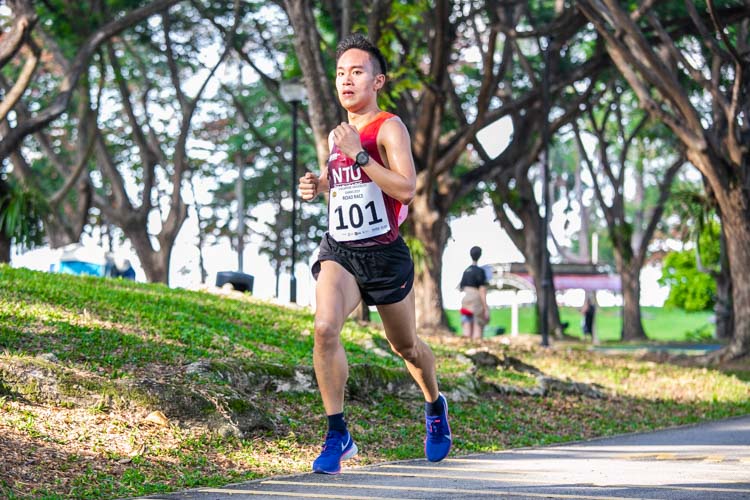
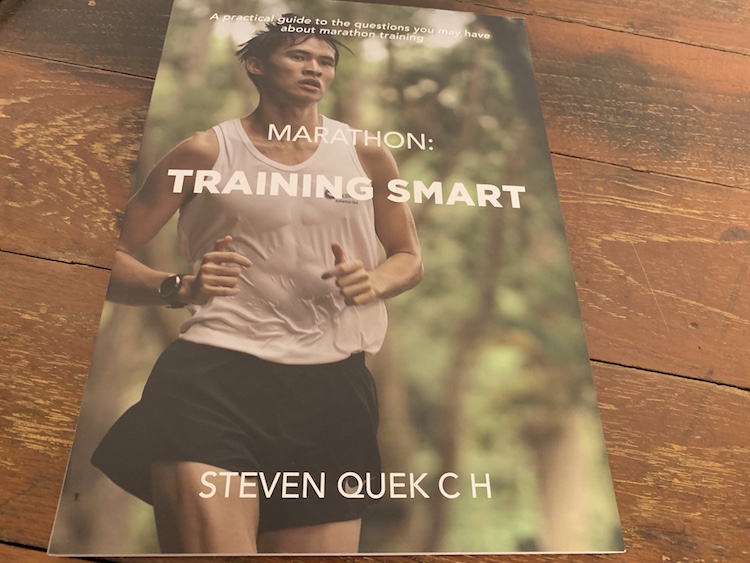

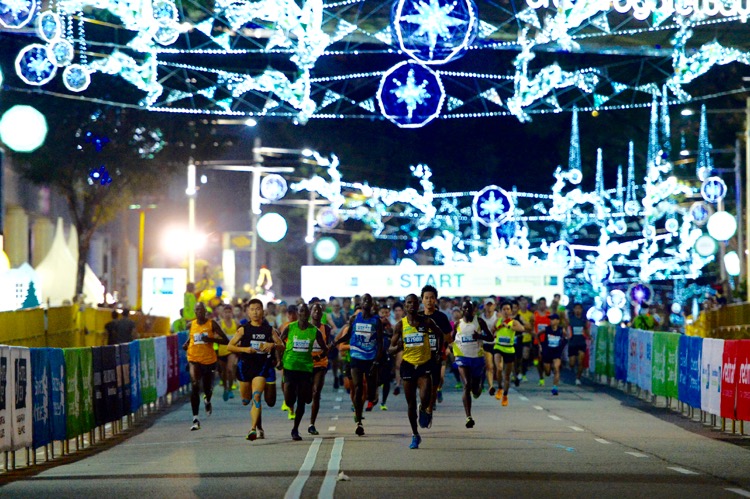
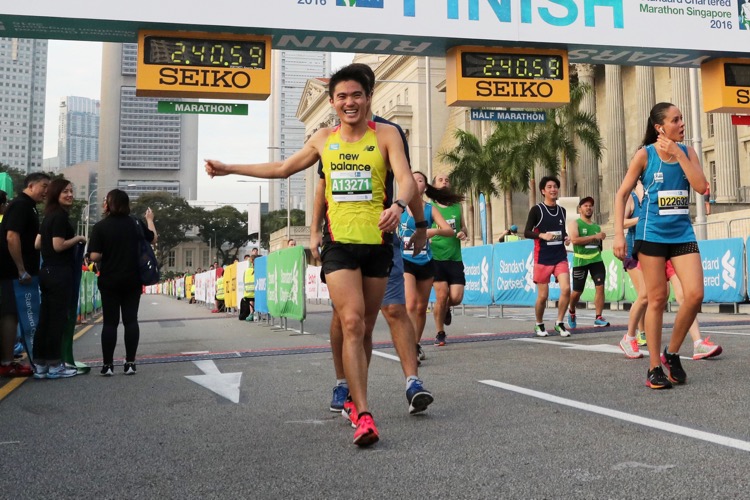
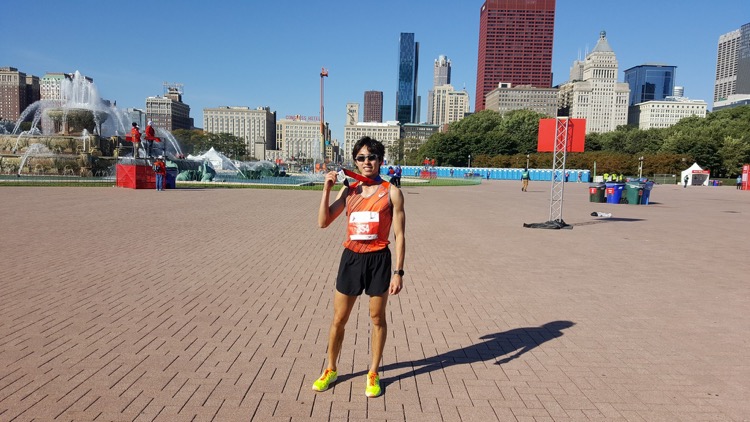
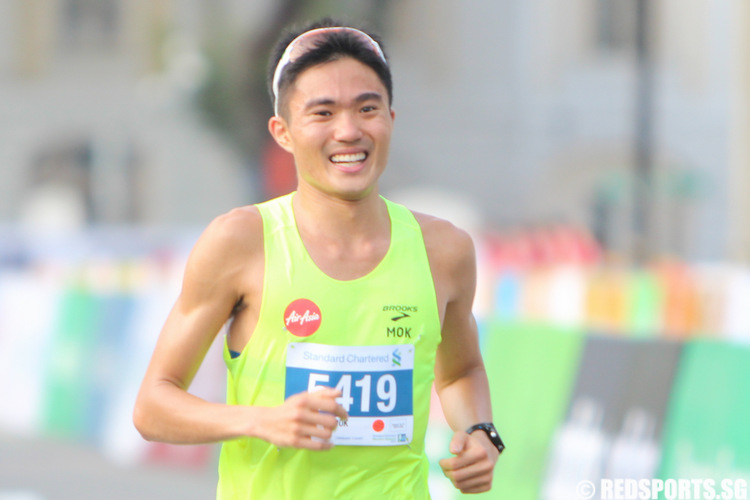
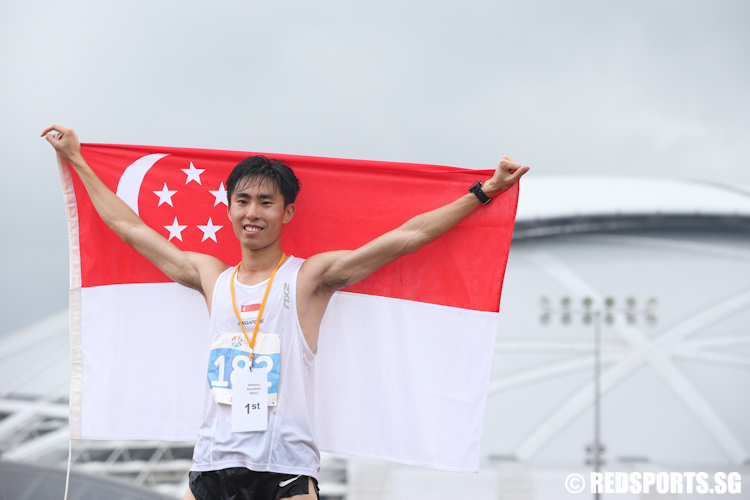
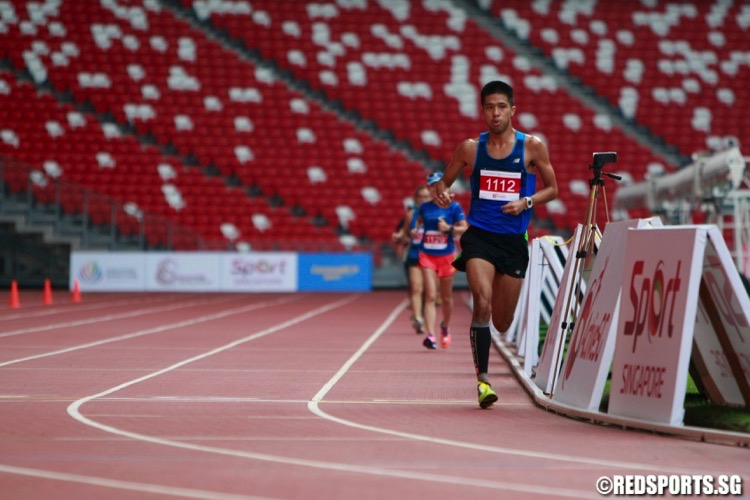
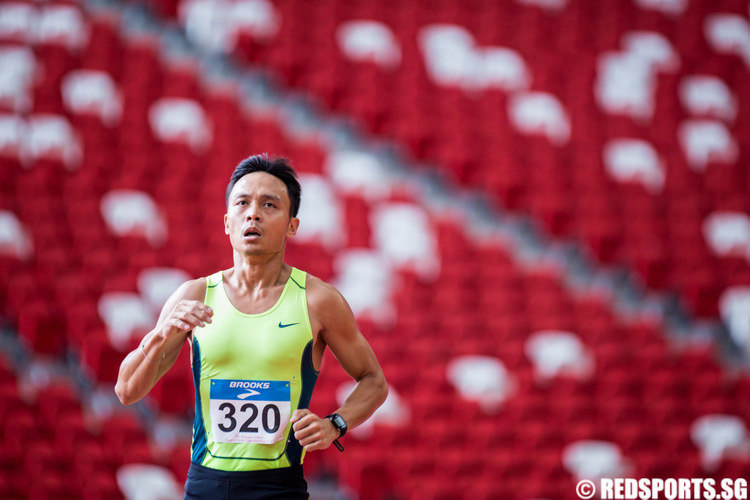
Leave A Comment